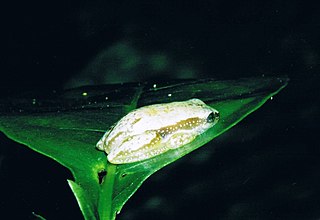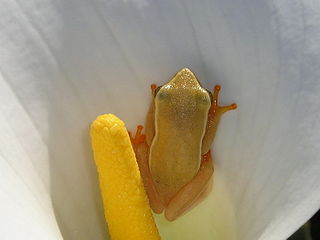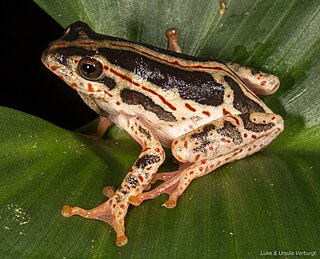
Hyperolius argus, known under common names Argus reed frog, Argus sedge frog, and Boror reed frog is a hyperolid frog found in the eastern coastal plain of Africa from southern Somalia through Kenya, Tanzania, Mozambique, Malawi, Zimbabwe to KwaZulu-Natal in eastern South Africa.

Afrixalus delicatus, the delicate leaf-folding frog, delicate spiny reed frog or Pickersgill's banana frog, is a species of frogs in the family Hyperoliidae. It is found in Southern and Eastern Africa, from eastern South Africa and Eswatini northward through Mozambique, the low altitude parts of Malawi and Tanzania, southeastern Kenya to southern Somalia.
Hyperolius microps is a species of frogs in the family Hyperoliidae. It is known with some certainty from northern Malawi, extreme northern Mozambique, Tanzania, and coastal Kenya; presumably its range extends into adjacent Zambia. However, its range and delimitation differs widely between sources.

Hyperolius poweri is a species of frogs in the family Hyperoliidae. It is found in southeastern coast of South Africa and southern Mozambique. The specific name poweri honours John Hyacinth Power, Irish-born director of the McGregor Museum who collected amphibians as well as reptiles and plants. Accordingly, common names Power's reed frog and Power's long reed frog have been proposed for this species.

Hyperolius benguellensis is a species of frog in the family Hyperoliidae. It is found in southern Angola and northern Botswana and Namibia, but other sources cite a wider and more eastern distribution. It is similar to Hyperolius nasutus and have been considered a synonym of that species. Hyperolius benguellensis is not considered threatened.

Hyperolius castaneus is a species of frogs in the family Hyperoliidae. It is found in the highlands of western Burundi, Rwanda, and Uganda as well as eastern Democratic Republic of the Congo. Common names of this species include Ahl's reed frog, brown reed frog, and montane reed frog. The status of the putative subspecies Hyperolius castaneus rhodogaster is unclear, and it may actually be a distinct species. Also Hyperolius constellatus, now a distinct species, was formerly recognized as a subspecies of H. castaneus.
Hyperolius glandicolor is a species of frog in the family Hyperoliidae. It is known from southern Somalia, Kenya, Tanzania, Rwanda, and Burundi. The limits of its distribution, however, are uncertain, and it might also occur in Malawi, Mozambique, Uganda, and even eastern Democratic Republic of the Congo. Common name Peters reed frog has been coined for it.

The arum frog, Horstock's arum-frog, arum lily frog, or Horstock's reed frog is a species of frog in the family Hyperoliidae. It is endemic to South Africa.
Hyperolius kuligae is a species of frog in the family Hyperoliidae. It is found in southwestern Cameroon, Gabon, and Equatorial Guinea and eastward to the central Democratic Republic of the Congo; it probably occurs in northern Republic of the Congo and the Central African Republic too. It is also reported from Uganda, but the status of this population is unclear. The specific name kuligae honours Paul Kuliga (1878–1948), a physician who joined an expedition to Cameroon in 1936. Common names Camp Kivu reed frog and Kuliga reed frog have been proposed for it.

Hyperolius mitchelli is a species of frogs in the family Hyperoliidae. It is found in the area between northeastern Tanzania, Malawi, and central Mozambique.
Hyperolius montanus is a species of frog in the family Hyperoliidae. It is endemic to Kenya and known from the Kenya Highlands. It might represent more than one species.

Hyperolius nasutus is a species of frog in the family Hyperoliidae. Common names include long-nosed reed frog, sharp-nosed reed frog and long reed frog. It is known from northern Angola and northern Botswana, but it presumably occurs more widely. The nominal Hyperolius nasutus was partitioned in 2013 into three cryptic species, the other two being Hyperolius viridis and Hyperolius microps. All these species are members of the so-called Hyperolius nasutus species group, the "long reed frogs".
Hyperolius nitidulus is a species of frog from the family Hyperoliidae. It is found on the West African savannas between Guinea and Mali in the west and Nigeria and Cameroon in the east. Common name plain reed frog has been coined for it.
Hyperolius pseudargus, also known as the Mette's reed frog, is a species of frogs in the family Hyperoliidae. It is endemic to south-central Tanzania and occurs in the Udzungwa Mountains and south to Njombe in the Southern Highlands. Male Hyperolius pseudargus greatly resemble Hyperolius argus but have less webbing between the toes and the male advertisement call is different. The vernacular name refers to Mette Westergaard, Danish biologist who collected the holotype and is the junior describer of this species.
Hyperolius sheldricki is a species of small frog in the family Hyperoliidae. It is endemic to southeast Kenya. The type locality is in the Tsavo East National Park.

Hyperolius spinigularis is a species of frog in the family Hyperoliidae. It is found in the Mulanje Massif in southern Malawi and the Namuli Massif in adjacent Mozambique. Records from Tanzania refers to other species. Males of this species have characteristic small spines during the breeding season. Its common names are spiny-throated reed frog, spiny reed frog, and Mulanje reed frog.

Hyperolius swynnertoni is a species of frog in the family Hyperoliidae. It is found in the southern portion of the eastern Zimbabwe uplands and adjacent Mozambique. It is also known as the Swynnerton's reed frog, with the subspecies "broadleyi" as the Broadley's tree frog or Broadley's forest treefrog.

The common reed frog is a species of tree frogs in the family Hyperoliidae found in Burundi, the Democratic Republic of the Congo, Ethiopia, Kenya, Rwanda, Sudan, Tanzania, and Uganda, and possibly the Central African Republic, Chad, and Eritrea. Its natural habitats are subtropical or tropical dry forest, subtropical or tropical moist lowland forest, subtropical or tropical moist montane forest, dry savanna, moist savanna, subtropical or tropical dry shrubland, subtropical or tropical moist shrubland, subtropical or tropical seasonally wet or flooded lowland grassland, subtropical or tropical high-altitude grassland, rivers, swamps, freshwater lakes, intermittent freshwater lakes, freshwater marshes, intermittent freshwater marshes, freshwater springs, arable land, pastureland, rural gardens, urban areas, heavily degraded former forests, water storage areas, ponds, irrigated land, seasonally flooded agricultural land, and canals and ditches.

Leptopelis flavomaculatus is a species of frog in the family Arthroleptidae. It is found in the lowlands eastern and southern Africa, from Mozambique north of the Save River and Zimbabwe to Malawi, eastern Tanzania, and coastal Kenya. Its common names are yellow-spotted tree frog, brown-backed tree frog, brown forest treefrog, and Johnston's treefrog.

Phrynobatrachus acridoides is a species of frog in the family Phrynobatrachidae. It is widely distributed in the lowlands of eastern Africa, from Kenya and southern Somalia in the north and southward to Tanzania, Malawi, Mozambique, eastern Zimbabwe, and easternmost South Africa (KwaZulu-Natal). Its range might extend into Eswatini in the south and westward to Uganda and Zambia. This widespread species has also many vernacular names: East African puddle frog, small puddle frog, eastern puddle frog, Zanzibar puddle frog, Zanzibar river frog, Mababe toad-frog, and Cope's toad-frog. It is morphologically and genetically most similar to Phrynobatrachus pakenhami, its sister species. However, the specific name acridoides appears to refer to its superficial similarity to the North American cricket frog Acris gryllus, of no close relation.


















